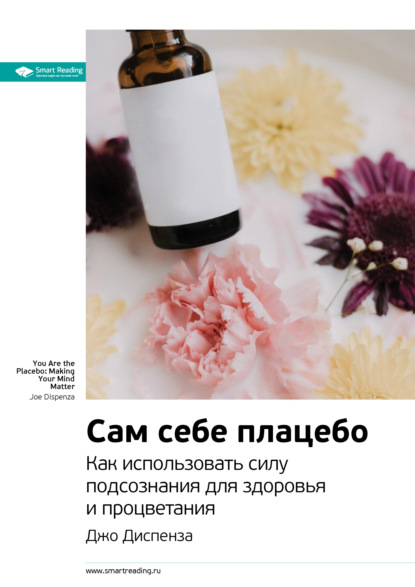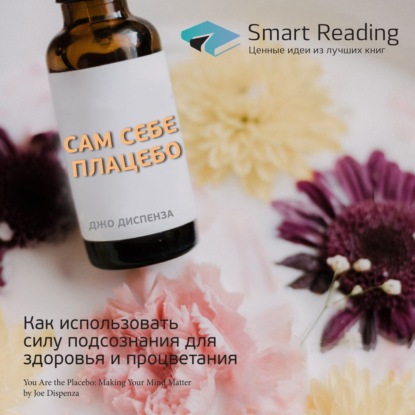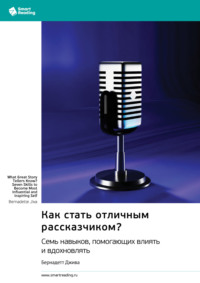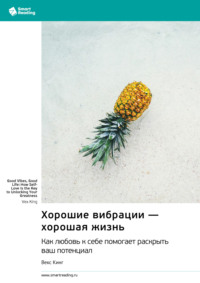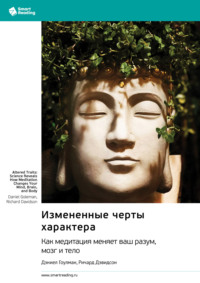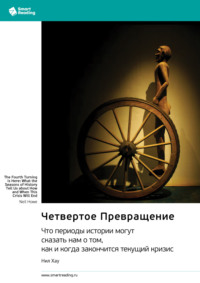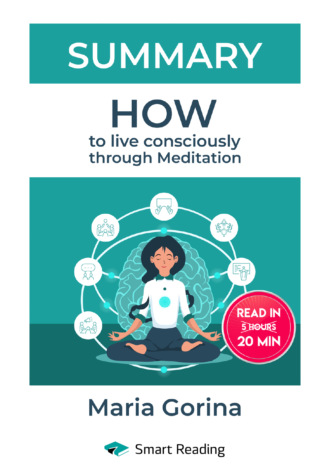
Полная версия
Summary: How to Live Mindfully with the Help of Meditation. Maria Gorina

Summary: How to Live Mindfully with the Help of Meditation. Maria Gorina
Автор:
Maria Gorina
Оригинальное название:
How to Live Mindfully with the Help of Meditation
www.smartreading.ru
What is Consciousness or Mindfulness
What does it mean to make decisions consciously, to have a mindful conversation, to drive consciously, to mindfully play with a child? Doesn’t it imply that we live in an unconscious state and that we require special training to live "inside ourselves"? That seems to be the case.
We spend a considerable part of life "on autopilot", existing mainly in our head rather than in reality. We eat while scrolling our Facebook feed, we drive while listening to some podcast, we make love while planning tomorrow’s meetings. The most beautiful sunset above the ocean cannot distract us from the consuming dialog we’re having with our inner critic and our reliving a failure that happened a year ago. No wonder the life we are living at this very moment gives us little pleasure and satisfaction. Yet, at the same time, everyone has experienced mindfulness at least once.
Try to remember a situation when you felt you were truly in the moment, being fully present and immersed in every passing second. What was it? Was it the birth of a child, finishing a marathon, the moment of your mother’s death? Was it the seconds before a car crash or the captivating feeling of being at one with nature while standing on a mountaintop?
Usually, it’s an experience beyond our daily routine, when time either disappears completely or stretches considerably, when one second feels like ten minutes. All the various episodes that have just come to mind share one thing in common – you were in same state of being: you were concentrating on the present to the max and were prepared to accept and live life it "as is" without evaluating or making judgements.
This state is known as "consciousness" or "mindfulness". There are three key points to it:
▶concentration;
▶acceptance;
▶non-judgement.
"Mindfulness is awareness that arises through paying attention, on purpose, in the present moment, non-judgementally."
Jon Kabat-Zinn"Mindfulness is the practice of complete presence in the moment, feeling alive, feeling harmony between body and brain."
Tit Nath KhanYou can develop mindfulness by being regularly aware of your thoughts, feelings, and sensations, while at the same time being aware of what is happening externally. This includes acceptance of and the ability to watch your thoughts and feelings without judgement, without labeling them "good" or "bad", "right" or "wrong". By practicing mindfulness, people learn to focus on what they are experiencing at a given moment without getting distracted by thoughts about the past or the future.
Mindfulness is organic to human nature as this mechanism is already preinstalled in us. It’s not so much the study of, as it is the recollection of our experience and dispersing it over the meaningful part of our life.
Why Practice Mindfulness
Possessing a mindful attitude makes our lives richer, brighter and fuller. Living mindfully, we live longer because our lifespan is not measured by the number or years lived, but by the amount and fullness of accumulated and integrated experiences. Your ability to submerge yourself into your own life and mindfully perceive every minute of it returns true value to your life.
"Mindfulness brings concentration into to our lives. When we are concentrated on life, it becomes deeper, and we acquire joy and harmony. We can live any activity mindfully: drive mindfully, peel carrots mindfully, shower mindfully. When our level of concentration grows we are able to penetrate the essence of things and experience a revelation."
Tit Nath KhanDaniel Goleman in his last book "Altered Traits", which he co-authored with Richard Davidson, shares the results of years-long research that focused on the brains of people with varying levels of experience in meditation (mindfulness practice). It’s clear that meditation develops the ability to concentrate. But that was known before these scientific experiments.
The most amazing discovery was the fact, which was scientifically proven, that by meditating people develop prefrontal cortex regions – the very part of the brain that makes people people. The cortex is responsible for planning, being organized, will (e. g., to live, survive), and sense of responsibility. Here lie the centers that determine to what degree emotional intelligence is developed. Meditation improves communication between the amygdala (our reptile part of brain that produces instant reactions like fight-or-flight) and the prefrontal cortex. People practicing mindfulness are more stress-resistant, perceive their environment and life situations in a more harmonious way. And are simply healthier. But that’s not all. Goleman’s team discovered that by practicing mindfulness while engaging in certain types of meditation (loving kindness, compassion) people can literally become kinder and more compassionate in the long term.
Another amazing discovery Goleman and Davidson made was that a total amount of being mindful, between 1000 to 10000 hours (including both regular individual practice and intense week-long retreats with an experienced teacher), can transform temporary characteristics acquired during meditation into stable personal qualities. Therefore, concentration, balance, being at peace with the world, kindness, and compassion can become permanent personal qualities with the help of meditation.
How to Develop Mindfulness
The ability to observe "from the outside looking in" all life’s phenomena, manifested both in and around you, is a "setting" that is important to activate as often as possible. To fully develop mindfulness, work at becoming an attentive observer who is really captivated by the object of his or her observation, but at the same time impartial.
Observers can live only in the now. For them there is no past and the future has yet to transpire, therefore there is nothing they missed – or that is yet to be observed. Your mindfulness is strengthening with every second of your existence in the now and with your connection to reality. Inhaling, exhaling – breathing is in the now; the chirping of birds – this sound is the now; pain in your knee – the sensation is in the now; tingling in your stomach, joyful anticipation – this emotion is in the now. We can agree on distinguishing several areas of people’s mindful existence. Being mindful of their:
Конец ознакомительного фрагмента.
Текст предоставлен ООО «ЛитРес».
Прочитайте эту книгу целиком, купив полную легальную версию на ЛитРес.
Безопасно оплатить книгу можно банковской картой Visa, MasterCard, Maestro, со счета мобильного телефона, с платежного терминала, в салоне МТС или Связной, через PayPal, WebMoney, Яндекс.Деньги, QIWI Кошелек, бонусными картами или другим удобным Вам способом.




